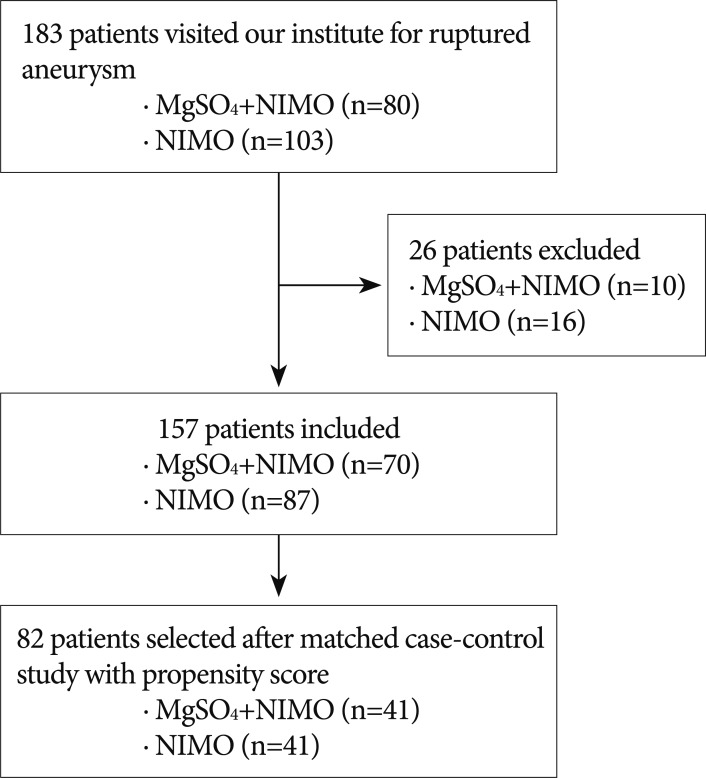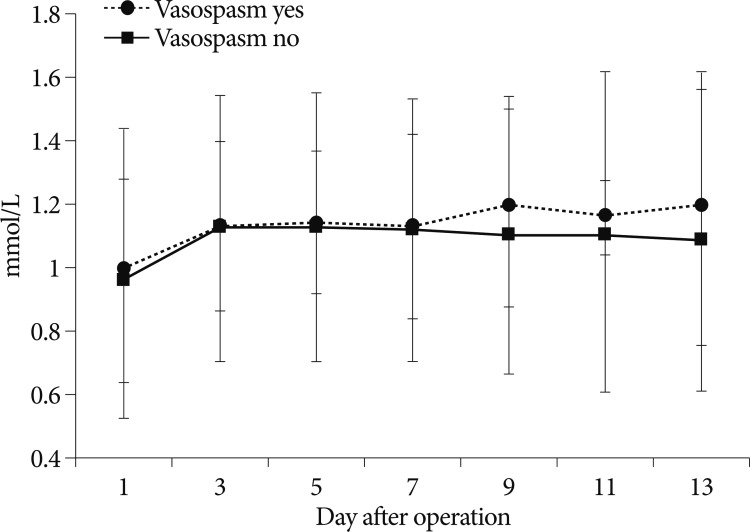J Korean Neurosurg Soc.
2012 Aug;52(2):75-79. 10.3340/jkns.2012.52.2.75.
Intravenous Magnesium Infusion for the Prevention of Symptomatic Cerebral Vasospasm after Aneurysmal Subarachnoid Hemorrhage
- Affiliations
-
- 1Department of Neurosurgery, Hallym University College of Medicine, Chuncheon Sacred Heart Hospital, Chuncheon, Korea. neurosheen@gmail.com
- KMID: 2190542
- DOI: http://doi.org/10.3340/jkns.2012.52.2.75
Abstract
OBJECTIVE
The study examined the difference in the incidence of symptomatic cerebral vasospasm with magnesium supplementation in aneurysmal subarachnoid hemorrhage (SAH) in a Korean population.
METHODS
This retrospective analysis was performed in 157 patients diagnosed with aneurysmal SAH from January 2007 to December 2011 at a single center. Seventy patients (44.6%) received a combination treatment of nimodipine with magnesium and 87 patients (55.4%) received only nimodipine. A matched case-control study using propensity scores was conducted and 41 subjects were selected from each group. A dosage of 64 mmol/day of magnesium was administrated.
RESULTS
The infusion of magnesium did not reduce the incidence of symptomatic cerebral vasospasm (n=7, 17.1%, p=0.29) compared with simple nimodipine injection (n=11, 26.8%). The ratios of good clinical outcome (modified Rankin scale 0-2) at 6 months were similar, being 78% in the combination treatment group and 80.5% in the nimodipine only group (p=0.79). The proportions of delayed cerebral infarction was not significantly lower in patients with combination treatment (n=2, 4.9% vs. n=3, 7.3%; p=0.64). There was no difference in the serum magnesium concentrations between the patients with symptomatic vasospasm and without vasospasm who had magnesium supplementation. No major complications associated with intravenous magnesium infusion were observed.
CONCLUSION
Magnesium supplementation (64 mmol/day) may not be beneficial for the reduction of the incidence of symptomatic cerebral vasospasm in patients with aneurysmal SAH.
MeSH Terms
Figure
Reference
-
1. Altura BT, Altura BM. Interactions of Mg and K on cerebral vessels--aspects in view of stroke. Review of present status and new findings. Magnesium. 1984; 3:195–211. PMID: 6399342.2. Barbarawi M, Smith SF, Jamous MA, Haboub H, Suhair Q, Abdullah S. Therapeutic approaches to cerebral vasospasm complicating ruptured aneurysm. Neurol Int. 2009; 1:e13. PMID: 21577350.
Article3. Biondi A, Ricciardi GK, Puybasset L, Abdennour L, Longo M, Chiras J, et al. Intra-arterial nimodipine for the treatment of symptomatic cerebral vasospasm after aneurysmal subarachnoid hemorrhage : preliminary results. AJNR Am J Neuroradiol. 2004; 25:1067–1076. PMID: 15205150.4. Boet R, Mee E. Magnesium sulfate in the management of patients with Fisher Grade 3 subarachnoid hemorrhage : a pilot study. Neurosurgery. 2000; 47:602–606. discussion 606-607. PMID: 10981747.
Article5. Collignon FP, Friedman JA, Piepgras DG, Pichelmann MA, McIver JI, Toussaint LG 3rd, et al. Serum magnesium levels as related to symptomatic vasospasm and outcome following aneurysmal subarachnoid hemorrhage. Neurocrit Care. 2004; 1:441–448. PMID: 16174947.
Article6. Friedlich D, Agner C, Boulos AS, Mesfin F, Feustel P, Bernardini GL, et al. Retrospective analysis of parenteral magnesium sulfate administration in decreased incidence of clinical and neuroradiological cerebral vasospasm : a single center experience. Neurol Res. 2009; 31:621–625. PMID: 19660191.
Article7. Keyrouz SG, Diringer MN. Clinical review : prevention and therapy of vasospasm in subarachnoid hemorrhage. Crit Care. 2007; 11:220. PMID: 17705883.
Article8. Macdonald RL, Curry DJ, Aihara Y, Zhang ZD, Jahromi BS, Yassari R. Magnesium and experimental vasospasm. J Neurosurg. 2004; 100:106–110. PMID: 14743919.
Article9. Mori K, Yamamoto T, Miyazaki M, Hara Y, Aiko Y, Koike N, et al. Optimal cerebrospinal fluid magnesium ion concentration for vasodilatory effect and duration after intracisternal injection of magnesium sulfate solution in a canine subarachnoid hemorrhage model. J Neurosurg. 2011; 114:1168–1175. PMID: 21073257.
Article10. Mori K, Yamamoto T, Nakao Y, Osada H, Hara Y, Oyama K, et al. Initial clinical experience of vasodilatory effect of intra-cisternal infusion of magnesium sulfate for the treatment of cerebral vasospasm after aneurysmal subarachnoid hemorrhage. Neurol Med Chir (Tokyo). 2009; 49:139–144. discussion 144-145. PMID: 19398856.
Article11. Muir KW, Lees KR, Ford I, Davis S. Magnesium for acute stroke (Intravenous Magnesium Efficacy in Stroke trial : randomised controlled trial). Lancet. 2004; 363:439–445. PMID: 14962524.12. Polin RS, Coenen VA, Hansen CA, Shin P, Baskaya MK, Nanda A, et al. Efficacy of transluminal angioplasty for the management of symptomatic cerebral vasospasm following aneurysmal subarachnoid hemorrhage. J Neurosurg. 2000; 92:284–290. PMID: 10659016.
Article13. Rubin DB, Thomas N. Combining propensity score matching with additional adjustments for prognostic covariates. J Am Stat Assoc. 2000; 95:573–585.
Article14. Sang N, Meng Z. Blockade by magnesium of sodium currents in acutely isolated hippocampal CA1 neurons of rat. Brain Res. 2002; 952:218–221. PMID: 12376182.
Article15. Satoh A, Sugiyama T, Ooigawa H, Nakajima H, Ogura T, Neki H, et al. Prevention of symptomatic vasospasm by continuous cisternal irrigation with mock-CSF containing ascorbic acid and Mg 2. Acta Neurochir Suppl. 2010; 107:115–118. PMID: 19953382.16. van den Bergh WM, Albrecht KW, Berkelbach van der Sprenkel JW, Rinkel GJ. Magnesium therapy after aneurysmal subarachnoid haemorrhage a dose-finding study for long term treatment. Acta Neurochir (Wien). 2003; 145:195–199. discussion 199. PMID: 12632115.
Article17. van den Bergh WM, Algra A, van der Sprenkel JW, Tulleken CA, Rinkel GJ. Hypomagnesemia after aneurysmal subarachnoid hemorrhage. Neurosurgery. 2003; 52:276–281. discussion 281-282. PMID: 12535355.
Article18. van den Bergh WM, Algra A, van Kooten F, Dirven CM, van Gijn J, Vermeulen M, et al. Magnesium sulfate in aneurysmal subarachnoid hemorrhage : a randomized controlled trial. Stroke. 2005; 36:1011–1015. PMID: 15790946.
Article19. van den Bergh WM, Dijkhuizen RM, Rinkel GJ. Potentials of magnesium treatment in subarachnoid haemorrhage. Magnes Res. 2004; 17:301–313. PMID: 15726906.20. Veyna RS, Seyfried D, Burke DG, Zimmerman C, Mlynarek M, Nichols V, et al. Magnesium sulfate therapy after aneurysmal subarachnoid hemorrhage. J Neurosurg. 2002; 96:510–514. PMID: 11883835.
Article21. Westermaier T, Stetter C, Vince GH, Pham M, Tejon JP, Eriskat J, et al. Prophylactic intravenous magnesium sulfate for treatment of aneurysmal subarachnoid hemorrhage : a randomized, placebo-controlled, clinical study. Crit Care Med. 2010; 38:1284–1290. PMID: 20228677.
Article22. Wong GK, Poon WS, Chan MT, Boet R, Gin T, Ng SC, et al. Intravenous magnesium sulphate for aneurysmal subarachnoid hemorrhage (IMASH) : a randomized, double-blinded, placebo-controlled, multicenter phase III trial. Stroke. 2010; 41:921–926. PMID: 20378868.
Article23. Wong GK, Poon WS, Chan MT, Boet R, Gin T, Ng SC, et al. Plasma magnesium concentrations and clinical outcomes in aneurysmal subarachnoid hemorrhage patients : post hoc analysis of intravenous magnesium sulphate for aneurysmal subarachnoid hemorrhage trial. Stroke. 2010; 41:1841–1844. PMID: 20538692.
Article24. Yahia AM, Kirmani JF, Qureshi AI, Guterman LR, Hopkins LN. The safety and feasibility of continuous intravenous magnesium sulfate for prevention of cerebral vasospasm in aneurysmal subarachnoid hemorrhage. Neurocrit Care. 2005; 3:16–23. PMID: 16159090.
- Full Text Links
- Actions
-
Cited
- CITED
-
- Close
- Share
- Similar articles
-
- Relation between Thromboembolism and Delayed Ischemic Neurological Deficits in Aneurysmal Subarachnoid Hemorrhage
- Evaluation of Subarachnoid Hemorrhage due to Aneurysmal Rupture and Cerebral Vasospasm by CT
- Intraarterial Nimodipine Infusion to Treat Symptomatic Cerebral Vasospasm after Aneurysmal Subarachnoid Hemorrhage
- Endovascular Treatment of Symptomatic Vasospasm after Aneurysmal Subarachnoid Hemorrhage: A Three-year Experience
- Effect of Intra-Arterial Nimodipine Infusion for the Treatment of Symptomatic Cerebral Vasospasm Following an Aneurysmal Subarachnoid Hemorrhage



